Question 1.
By comparing the ratios a1/a2, b1/b2, c1/c2 K find out whether the lines represented by the following pairs of linear equations intersect at a point, are parallel or are coincident.
a) 5x - 4y + 8 = 0
7x + 6y - 9 = 0
Answer:
Given: 5x - 4y + 8 = 0
7x + 6y - 9 = 0
a1/a2 = 5/7; b1/b2 = -4/6; c1/c2 = 8/-9
∴ a1/a2 ≠ b1/b2
Hence the given pair of linear equations represents a pair of intersecting lines.
b) 9x + 3y + 12 = 0
18x + 6y + 24 = 0
Answer:
Given : 9x + 3y + 12 = 0
18x + 6y + 24= 0
a1/a2 = 9/18 = 1/2;
b1/b2 = 3/6 = 1/2;
c1/c2 = 12/24 = 1/2
∴ a1/a2 = b1/b2 = c1/c2
The lines are coincident.
c) 6x - 3y + 10 = 0
2x - y + 9 = 0
Answer:
Given: 6x - 3y + 10 = 0
2x - y + 9 = 0
a1/a2 = 6/2 = 3/1;
b1/b2 = -3/-1 = 3/1;
c1/c2 = 10/9
Here a1/a2 = b1/b2 ≠ c1/c2
∴ The lines are parallel.
Question 2.
Check whether the following equations are consistent or inconsistent. Solve them graphically. (AS2, AS5)
a) 3x + 2y = 8
2x - 3y = 1
Answer:
Given equaions are 3x + 2y = 8 and 2x - 3y = 1
a1/a2 = 3/2;
b2/b-3 = -4/6;
a1/a2 ≠ b1/b2
Hence the linear equations are consistent.

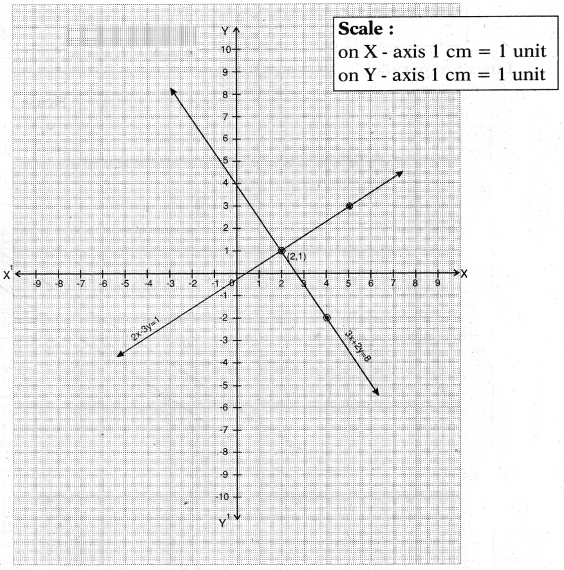
The lines intersect at (2, 1), so the solution is (2, 1).
b) 2x - 3y = 8
4x - 6y = 9
Answer:
Given: 2x - 3y = 8 and 4x - 6y = 9
a1/a2 = 2/4 = 1/2;
b1/b2 = -3/-6 = 1/2;
c1/c2 = 8/9
∴ a1/a2 = b1/b2 ≠ c1/c2
Lines are inconsistent and have no solution.

Lines are parallel.
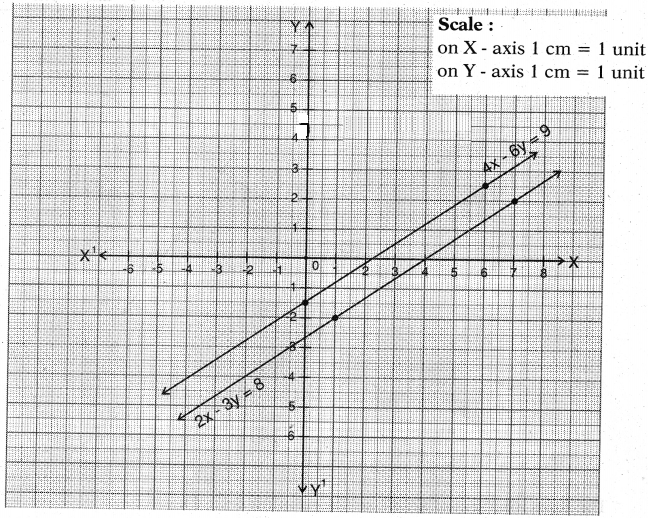
The lines are parallel and no solution exists.
c) 3/2 x + 5/3 y = 7
9x - 10y = 12
Answer:
Given pair of equations 3/2 x + 5/3 y = 7 and 9x - 10y = 12
Now take 3/2 x + 5/3 y = 7 ⇒ 9x+10y/6 = 7 ⇒ 9x + 10y = 42
and 9x - 10y =12
a1/a2 = 9/9 = 1/1;
b1/b2 = 10/-10 = 1/-1 and
c1/c2 = -42/-12 = 7/2
Since a1/a2 ≠ b1/b2 they are intersecting lines and hence consistent pair of linear equations.

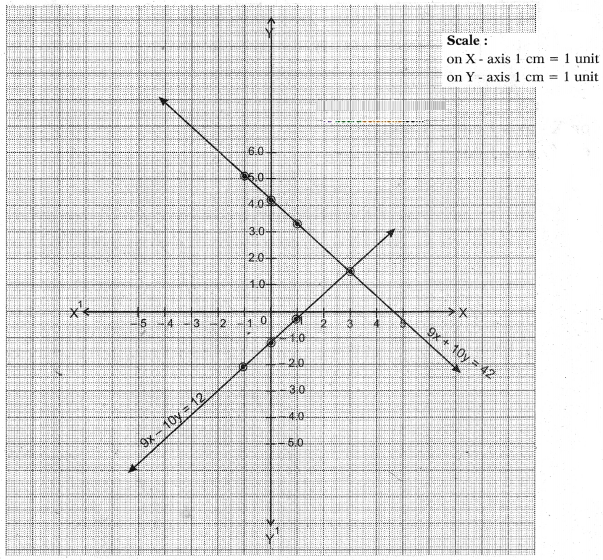
Solution: The unique solution of given pair of equations is (3.1, 1.4)
d) 5x - 3y = 11
-10x + 6y = -22
Answer:
Given pair of equations 5x - 3y = 11 and -10x + 6y = -22
a1/a2 = 5/-10 = -1/2;
b1/b2 = -3/6 = -1/2 and
c1/c2 = 11/-22 = -1/2
∴ a1/a2 = b1/b2 = c1/c2
∴ The lines are consistent.
∴ The given linear equations represent coincident lines.
Thus they have infinitely many solutions.

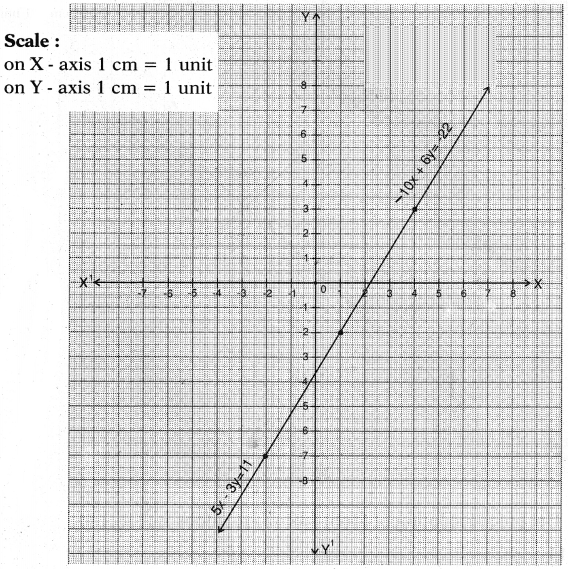
e) 4/3 x + 2y = 8
2x + 3y = 12
Answer:
Given pair of equations 4/3 x + 2y = 8 ⇒ 4x+6y/3 = 8 ⇒ 4x + 6y = 24 ⇒ 2x + 3y = 12
a1/a2 = 4/2 = 2;
b1/b2 = 6/3 = 2;
c1/c2 = 24/12 = 2
∴ a1/a2 = b1/b2 = c1/c2
Thus the equations are consistent.
∴ The given equations have infinitely many solutions.

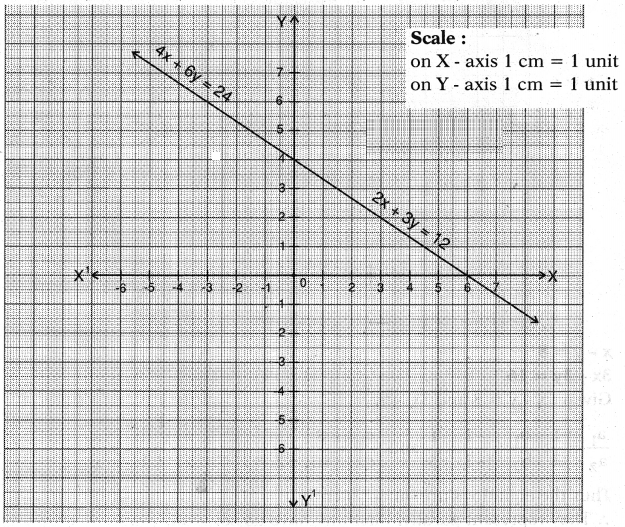
f) x + y = 5
2x + 2y = 10
Answer:
Given pair of equations x + y = 5 and 2x + 2y = 10
a1/a2 = 1/2;
b1/b2 = 1/2;
c1/c2 = 5/10 = 1/2
∴ a1/a2 = b1/b2 = c1/c2
Thus the equations are consistent and have infinitely many solutions.

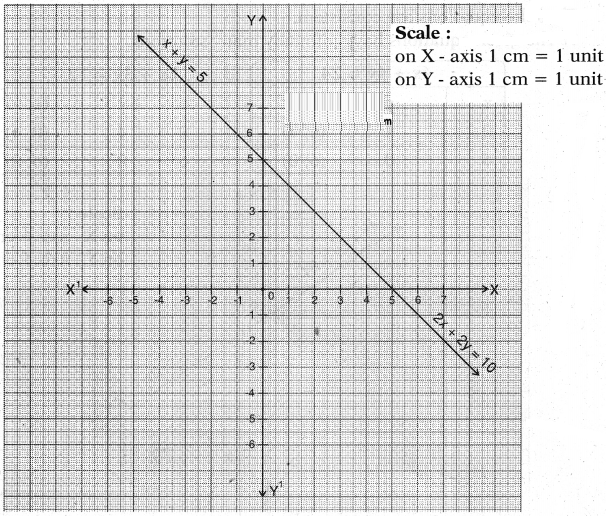
g) x - y = 8
3x - 3y = 16
Answer:
Given pair of equations x - y = 8 and 3x - 3y = 16
a1/a2 = 1/3;
b1/b2 = -1/-3 = 1/3 and
c1/c2 = 816 = 1/2
∴ a1/a2 = b1/b2 ≠ c1/c2
Thus the equations are inconsistent.
∴ They represent parallel lines and have no solution.
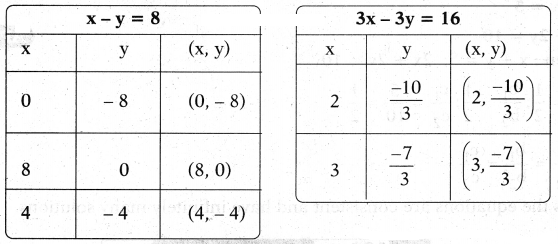
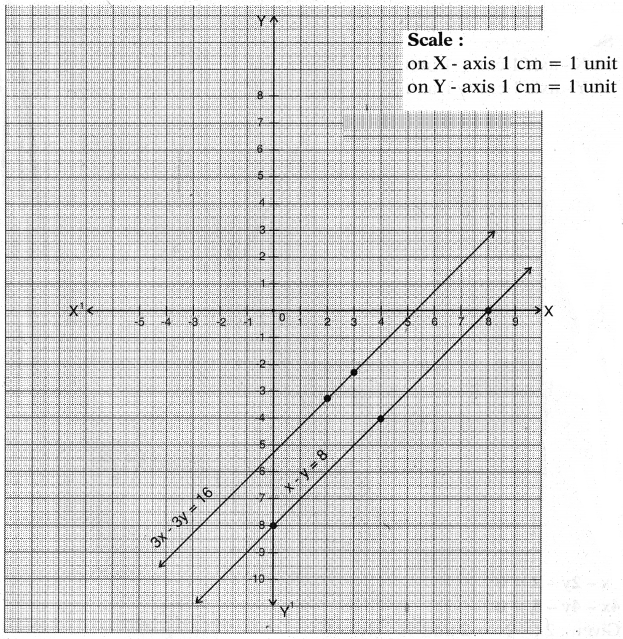
h) 2x + y - 6 = 0 and 4x - 2y - 4 = 0
Answer:
Given pair of equations 2x + y - 6 = 0 and 4x - 2y - 4 = 0
a1/a2 = 2/4 = 1/2;
b1/b2 = 1/-2 = -1/2;
c1/c2 = -6/-4 = 3/2
∴ a1/a2 ≠ b1/b2
The equations are consistent.
∴ They intersect at one point giving only one solution.

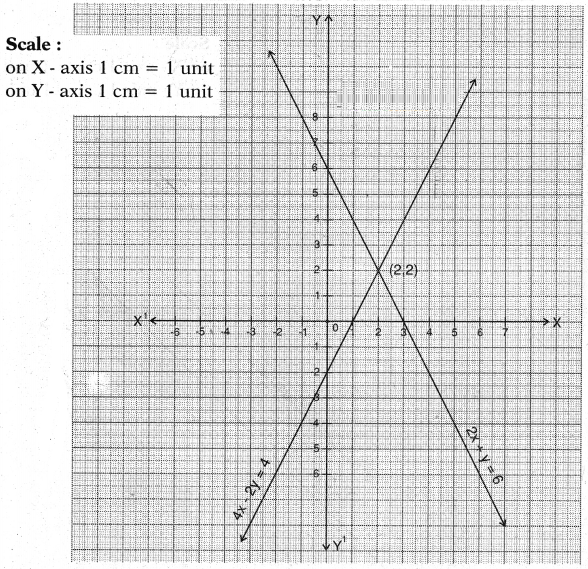
The solution is x = 2 and y = 2
i) 2x - 2y - 2 = 0 and 4x - 4y - 5 = 0
Answer:
Given pair of equations 2x - 2y - 2 = 0 and 4x - 4y - 5 = 0
a1/a2 = 2/4 = 1/2;
b1/b2 = -2/-4 = 1/2;
c1/c2 = -2/-5 = 2/5
∴ a1/a2 = b1/b2 ≠ c1/c2
Thus the equations are inconsistent.
∴ They represent parallel lines and have no solution.
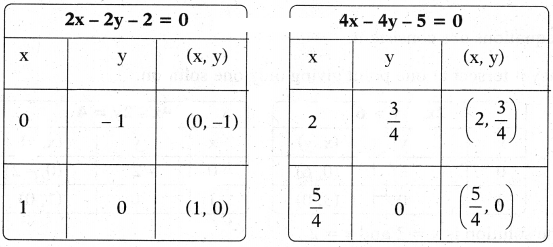
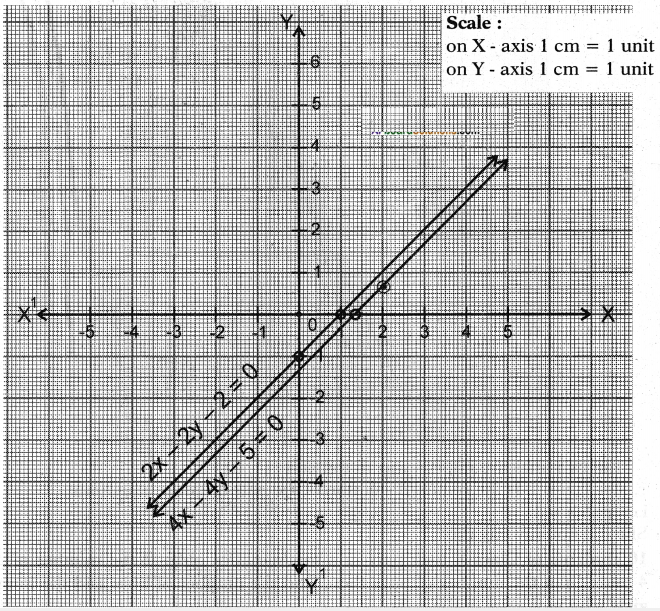
Question 3.
Neha went to a ‘sale’ to purchase some pants and skirts. When her friend asked her how many of each she had bought, she answered “The number of skirts are two less than twice the number of pants purchased. Also the number of skirts is four less than four times the number of pants purchased.”
Help her friend to find how many pants and skirts Neha bought.
Answer:
Let the number of pants = x and the number of skirts = y
By problem y = 2x - 2 ⇒ 2x - y = 2
y = 4x - 4 ⇒ 4x - y = 4

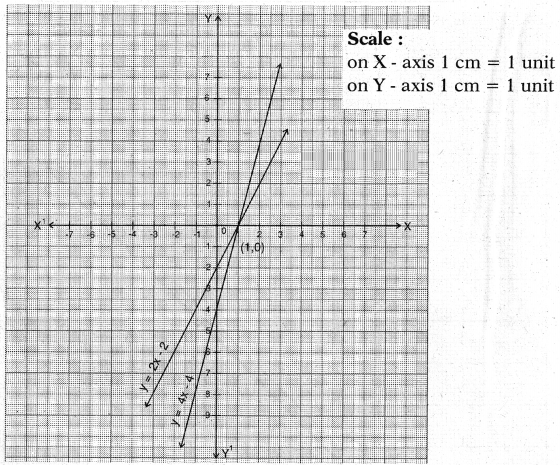
The two lines are intersecting at the point (1,0)
∴ x = 1; y = 0 is the required solution of the pair of linear equations.
i.e., pants =1
She did not buy any skirt.
Question 4.
10 students of Class-X took part in a mathematics quiz. If the number of girls is 4 more than the number of boys then, find the number of boys and the number of girls who took part in the quiz.
Answer:
Let the number of boys be x.
Then the number of girls = x + 4
By problem, x + x + 4 = 10
∴ 2x + 4 = 10
2x = 10-4
x =6/2= 3
∴ Boys = 3 Girls = 3 + 4 = 7 (or)
Boys = x, Girls = y
By problem x + y = 10 (total)
and y = x + 4 (girls)
⇒ x + y = 10 and x - y = - 4

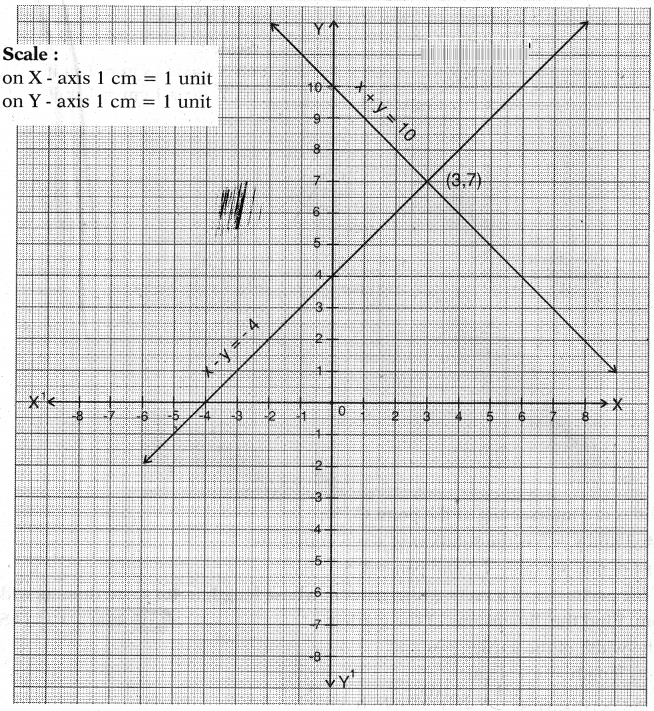
∴ Number of boys = 3 and the number of girls = 7
Question 5.
5 pencils and 7 pens together cost Rs. 50 whereas 7 pencils and 5 pens together cost Rs. 46. Find the cost of one pencil and that of one pen.
Answer:
Let the cost of each pencil be Rs. x
and the cost of each pen be Rs. y.
By problem 5x + 7y = 50
7x + 5y = 46

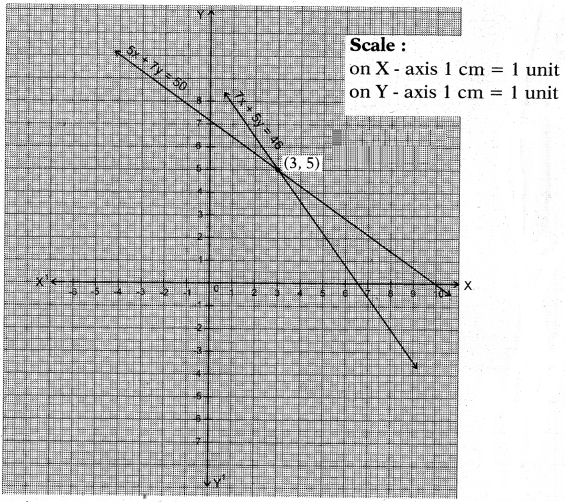
The lines are intersecting at the point (3, 5).
x = 3 and y = 5 is the solution of given equations.
∴ Cost of one pencil = Rs. 3 and pen = Rs. 5
Question 6.
Half the perimeter of a rectangular garden, whose length is 4 m more than its width is 36 m. Find the dimensions of the garden.
Answer:
Let the width of the garden = x cm
then its length = x + 4 cm
Half the perimeter = 1/2 × 2(7+ b) = l + b
By problem, x + x + 4 = 36
2x + 4 = 36
2x = 36 - 4 = 32
∴ x = 16 and x + 4 = 16 + 4 = 20
i.e., length = 20 cm and breadth = 16 cm.
(or)
Let the breadth be x and length = y
then x + y = 36 ⇒ x + y = 36
y = x + 4 ⇒ x - y = -4

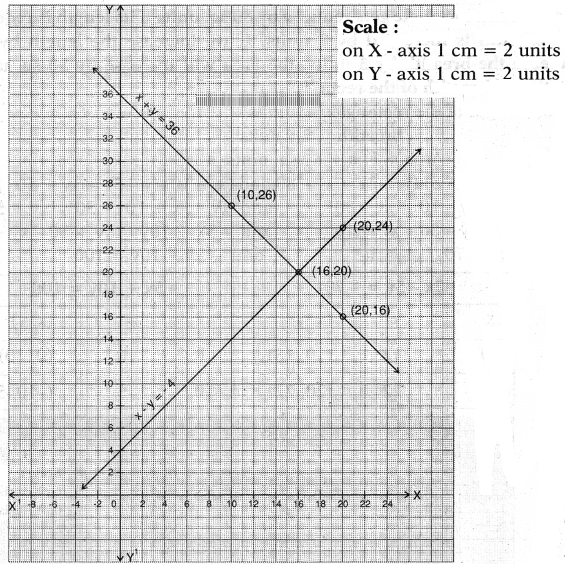
The two lines intersect at the point (16, 20)
i.e., length = 20 cm and the breadth = 16 cm.
Question 7.
We have a linear equation 2x + 3y - 8 = 0. Write another linear equation in two variables such that the geometrical representation of the pair so formed is intersect¬ing lines. Now, write two more linear equations so that one forms a pair of parallel lines and the second forms coincident line with the given equation.
Answer:
i) Given: 2x + 3y - 8 = 0
The lines are intersecting lines.
Let the other linear equation be ax + by + c = 0
∴ a1/a2≠b1/b2; we have to choose appropriate values satisfying the condition above.
Thus the other equation may be 3x + 5y - 6 =0
ii) Parallel line a1/a2 = b1/b2 ≠ c1/c2
⇒ 2x + 3y - 8 = 0
4x + 6y - 10 = 0
iii) Coincident lines a1/a2 = b1/b2 = c1/c2
⇒ 2x + 3y - 8 = 0 ⇒ 8x + 12y - 32 = 0
Question 8.
The area of a rectangle gets reduced by 80 sq. units if its length is reduced by 5 units and breadth is increased by 2 units. If we increase the length by 10 units and decrease the breadth by 5 units, the area will increase by 50 sq. units. Find the length and breadth of the rectangle.
Answer:
Let the length of the rectangle = x units
breadth = y units Area = l . b = xy sq. units
By problem, (x - 5) (y + 2) = xy - 80 and (x + 10) (y - 5) = xy + 50
⇒ xy + 2x - 5y - 10 = xy - 80 and xy - 5x + 10y - 50 = xy + 50
⇒ 2x - 5y = xy - 80 - xy + 10 and -5x + 10y = xy + 50 - xy + 50
⇒ 2x - 5y = - 70 and -5x + 10y = 100

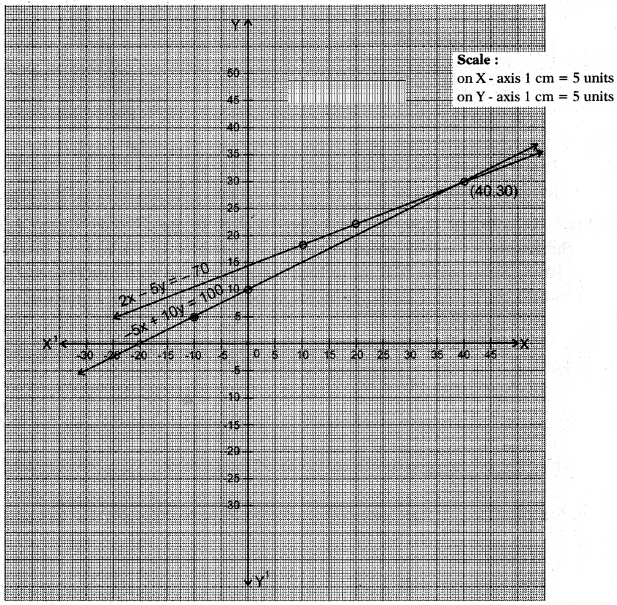
The two lines intersect at the point (40, 30)
∴ The solution is x = 40 and y = 30
i.e., length = 40 units; breadth = 30 units.
Question 9.
In X class, if three students sit on each bench, one student will be left. If four students sit on each bench, one bench will be left. Find the number of students and the number of benches in that class.
Answer:
Let the number of benches = x say and the number of students = y
By problem
y = 3x + 1 ⇒ 3x - y + 1 = 0
and y = 4(x - 1)⇒ 4x - y - 4 = 0

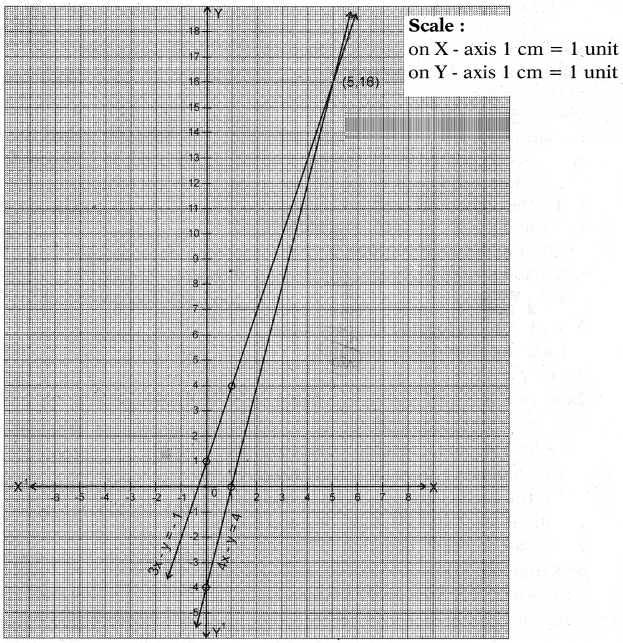
The two lines intersect at (5, 16)
∴ The solution of the equation is x = 5 and y = 16
i.e., Number of benches = 5 and the number of students = 16
Question 1.
The ratio of incomes of two persons is 9 : 7 and the ratio of their expenditures is 4 : 3. If each of them manages to save Rs. 2000 per month, find their monthly income.
Answer:
Given ratio of incomes of two persons = 9 : 7
So let the incomes of each = Rs. 9x and Rs. 7x
and ratio of expenditures = 4 : 3
So let the expenditures of each = 4y and 3y
then earnings of each = (income - expenditure) of each
⇒ 9x - 4y = Rs. 2000 and 7x - 3y = 200
∴ 9x - 4y = 7x - 3y = 2000
⇒ 9x - 7x = 4y - 3y
⇒ y = 2x
now putting y = 2x in 9x - 4y = 2000 we get
9x - 4(2x) = 2000 ⇒ x = 2000
∴ Income of each = 9x = 9(2000) = 18000
and 7x = 7(2000) = 14,000
Question 2.
The sum of a two digit number and the number obtained by reversing the digits is 66. If the digits of the number differ by 2, find the number. How many such numbers are there?
Answer:
Let the digit in units place be x
and the digit in tens place be y
then the value of the number = 10y + x
Number obtained by reversing the digits = 10x + y
By problem,
(10y + x) + (10x + y) = 66
and x - y = 2
⇒ 11x - 11y = 66 and x - y = 2
⇒ x + y = 6 and x - y = 2
Solving these two equations
x + y = 6
x – y = 2
(+) 2x = 8
x = 8/2 = 4
Substituting x = 4 in x + y = 6
we get 4 + y = 6 ⇒ y = 2
Substituting x, y values in equations (10y + x) & (10x + y),
We get 10y + x
= 10(2) + 4 = 20 + 4 = 24
and 10x + y = 10(4) + 2
= 40 + 2 = 42
∴ The number is 42 or 24
Thus we have two such numbers.
Question 3.
The larger of two supplementary angles exceeds the smaller by 18°. Find the angles.
Answer:
Let the pair of supplementary angles be x and y [and x > y]
then we have x + y = 180° …… (1)
By problem, x = y + 18°
⇒ x - y = 18° …… (2)
Solving the equations (1) and (2) we get

and x =198/2= 99°
Substituting x = 99° in equation (2) we get
99° - y° = 18°
⇒ y° = 99° - 18 = 81°
∴ The angles are 99° and 81°.
Question 4.
The taxi charges in Hyderabad are fixed, along with the charge for the distance covered. For a distance of 10 km., the charge paid is Rs. 220. For a journey of 15 km. the charge paid is Rs. 310.
i) What are the fixed charges and charge per km?
ii) How much does a person have to pay for travelling a distance of 25km?
Answer:
Let the fixed charge be = Rs. x.
and the charge per one km = Rs. y.
By problem, x + 10y = 220 x + 15y = 310
Solving (1) and (2) we get
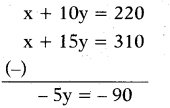
∴ y =-90/-5= 18
i.e., charge per one km = Rs. 18
Substituting y = 18 in equation (1) we get
x + 10 × 18 = 220
⇒ x = 220 - 180
⇒ x = Rs. 40
∴ Fixed charge = Rs. 40;
Charge per km = Rs. 18.
ii) Now, the charge for travelling a distance of 25 km = 25 × 18
= Rs. 450 + 40
= Rs. 490
Question 5.
A fraction becomes equal to 4/5 if 1 is added to both numerator and denominator. If, however, 5 is subtracted from both numerator and denominator, the fraction becomes equal to 12. What is the fraction?
Answer:
Let the numerator of the fraction = x
and the denominator of the fraction = y
By problem,
x+1/y+1 = 4/5 and x-5/y-5 = 1/2
⇒ 5(x + 1) = 4(y + 1) and 2(x - 5) = 1(y - 5)
5x + 5 = 4y + 4 and 2x - 10 = y - 5
⇒ 5x - 4y = 4 - 5 and 2x - y = - 5 + 10
⇒ 5x - 4y = - 1 …… (1)
and 2x - y = 5 …… (2)
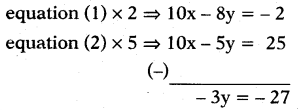
∴ y =-27/-3= 9
Substituting y = 9 in equation (2) we get
2x - 9 = 5
⇒ 2x = 5 + 9
⇒ 2x = 14 and
x =14/2= 7
Thus the fraction is x/y = 7/9
Question 6.
Places A and B are 100 km apart on a highway One car starts from A and another from B at the same time at different speeds. If the cars travel in the same direction, they meet in 5 hours. If they travel towards each other, they meet in 1 hour. What are the speeds of the two cars?
Answer:

Let the speed of the car which started from the place A = x kmph
and B = y kmph
Distance travelled by first car in 5h = 5x and in 1h = x
The distance covered by second car in 5h = 5y and in 1h = y
By problem when travelled in same direction,
5x - 5y = 100 ⇒ x - y = 20 …… (1)
and when travelled towards each other
x + y = 100 ……. (2)
Solving (1) and (2),
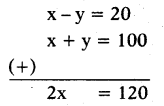
∴ x = 120/2 = 60
Substituting x = 60 in equation (1) we get
60 - y = 20
⇒ y = 60 - 20 = 40 kmph
Thus the speed of the cars are 60 kmph and 40 kmph.
Question 7.
Two angles are complementary. The larger angle is 3° less than twice the measure of the smaller angle. Find the measure of each angle.
Answer:
Let the pair of complementary angles be x° and y° with x° > y°
then x° + y° = 90° and
By problem
x = 2y - 3° ⇒ x - 2y = - 3°
Solving these two equations we get,
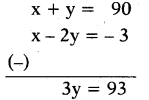
∴ y =93/3 = 31°
Substituting y = 31°in x + y = 90° we get
x + 31° = 90°
⇒ x = 90° - 31° = 59°
The angles are 59° and 31°.
Question 8.
An algebra textbook has a total of 1382 pages. It is broken up into two parts. The second part of the book has 64 pages more than the first part. How many pages are in each part of the book?
Answer:
Let the first part of the book contains x pages
and the second part of the book contains y pages By problem,
x + y = 1382 ….. (1)
y = x + 64 ⇒ x - y = -64 …… (2)
Solving equations (1) and (2) we get

∴ x = 1318/2 = 659
Substituting x = 659 in equation (1) we get
659 + y = 1382
⇒ y = 1382 - 659 = 723
∴ The number of pages in the first part = 659
Second part = 723
Question 9.
A chemist has two solutions of hydrochloric acid in stock. One is 50% solution and the other is 80% solution. How much of each should be used to obtain 100 ml of a 68% solution?
Answer:
Let the first solution contains 50% acid.
Second solution contains 80% acid.
Let x ml of 1st solution and y ml of second solution are added.
Then x + y = 100
Acid content in the ‘mix’ is 50% of x + 80% of y = 68%
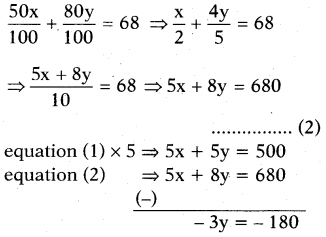
∴ y = 1803 = 60
Substituting y = 60 in equation (1) we get
x + 60 = 100
⇒ x = 100 - 60 = 40
∴ Quantity of first solution = 40 ml
Quantity of second solution = 60 ml
Question 10.
Suppose you have Rs. 12000 to invest. You have to invest some amount at 10% and the rest at 15%. How much should be invested at each rate to yield 12% on the total amount invested ?
Answer:
Let the amount to be invested @ 10% be Rs. x
and the amount to be invested @ 15% be Rs. y
By problem x + y = 12000 ……. (1)
Also 10% of x + 15% of y = 12% of 12000
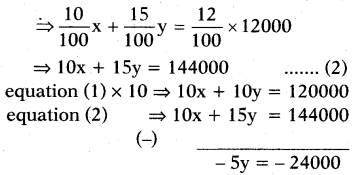
⇒ y = -24000/-5 = Rs. 4800
Substituting y = 4800 in equation (1) we get
x + 4800 = 12000
⇒ x = 12000 - 4800 = 7200
The invested @ 10% = Rs. 7200
@ 15% = Rs. 4800
Question 1.
Solve each of the following pairs of equations by reducing them to a pair of linear equations.
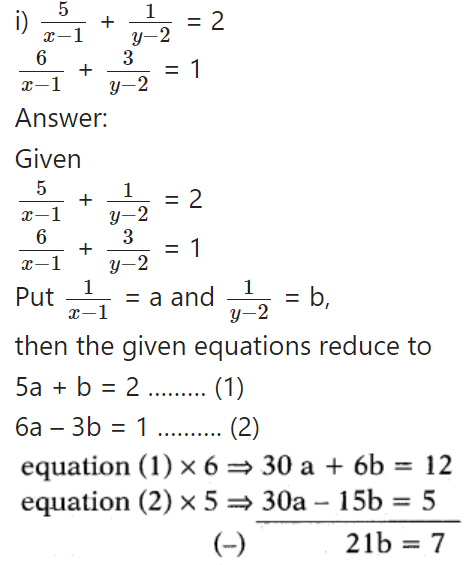
⇒ b = 7/21 = 1/3
Substituting b = 1/3 in equation (1) we get
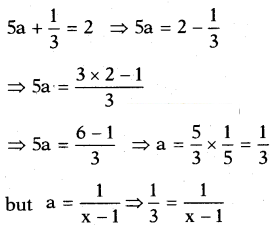
⇒ (x - 1) . 1 = 3 × 1
⇒ x - 1 = 3
⇒ x = 3 + 1 = 4
b = 1/y-2 ⇒ 1/3 = 1/y-2
⇒ (y - 2) . 1 = 3 × 1
⇒ y - 2 = 3
⇒ y = 3 + 2 = 5
∴ Solution (x, y) = (4, 5)
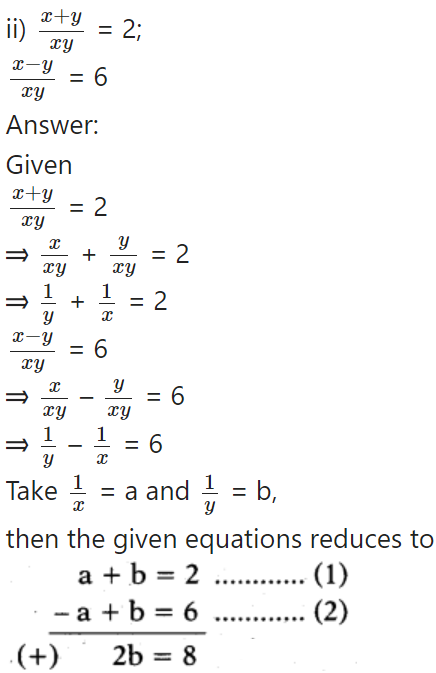
⇒ b = 82 = 4
Substituting b = 4 in equation (1) we get
a + 4 = 2 ⇒ a = 2 - 4 = -2
but a = 1/x = -2 ⇒ x = -1/2
b = 1/y = 4 ⇒ y = 1/4
∴ Solution (x, y) = (-1/2,1/4)
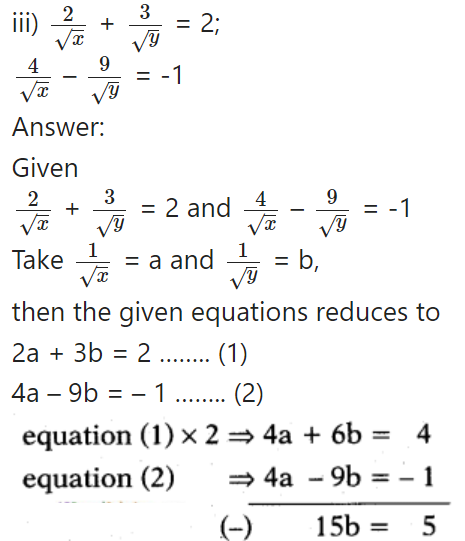
⇒ b = 5/15 = 1/3
Substituting b = 1/3 in equation (1) we get
2a + 3(1/3) = 2
⇒ 2a + 1 = 2 ⇒ 2a = 2 - 1 ⇒ a = 1/2
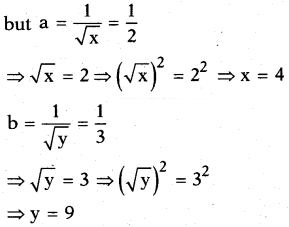
∴ Solution (x, y) = (4, 9)
iv) 6x + 3y = 6xy
2x + 4y = 5xy
Answer:
Given
6x + 3y = 6xy
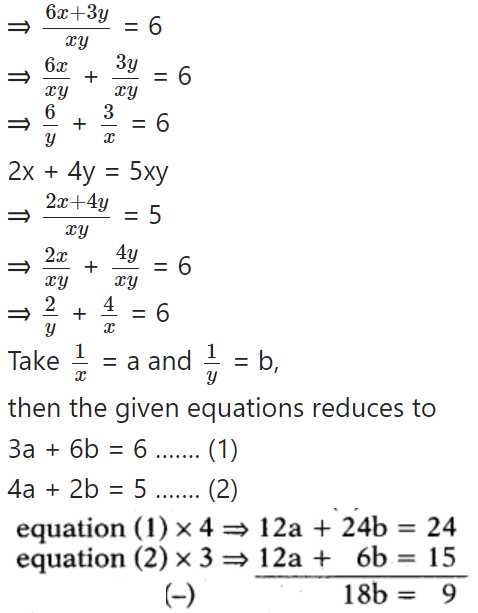
⇒ b = 9/18 = 1/2
Substituting b = 1/2 in equation (1) we get
3a +6(1/2) = 6
⇒ 3a = 6 - 3
⇒ a = 3/3 = 1
but a = 1/x = 1 ⇒ x = 1
b = 1/y = 1/2 ⇒ y = 2
∴ Solution (x, y) = (1, 2)
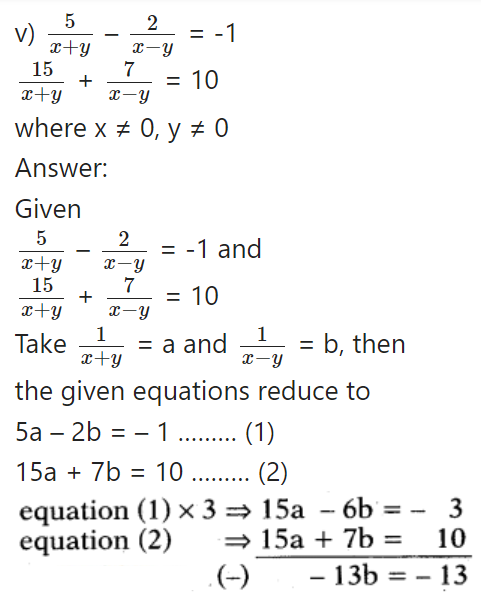
⇒ b = -13/-13 = 1
Substituting b = 1 in equation (1) we get
5a - 2(1) = -1
⇒ 5a = -1 + 2
⇒ 5a = 1
⇒ a = 1/5
but a = 1/x+y = 1/5 ⇒ x + y = 5
b = 1/x-y = 1 ⇒ x - y = 1
⇒ x = 6/2 = 3
Solving the above equations
Substituting x = 3 in x + y = 5 we get
3 + y = 5 ⇒ y = 5 - 3 = 2
∴ Solution (x, y) = (3, 2)
vi) 2/x + 3/y = 13
5/x - 4/y = -2
where x ≠ 0, y ≠ 0
Answer:
Given
2/x + 3/y = 13 and
5/x - 4/y = -2
Take 1/x = a and 1/y = b, then
the given equations reduce to
2a + 3b = 13 ……… (1)
5a - 4b = -2 ……… (2)

⇒ b = 69/23 = 3
Substituting b = 3 in equation (1) we get
2a + 3 (3) = 13
⇒ 2a = 13 - 9
⇒ a = 4/2 = 2
but a = 1/x = 2 ⇒ x = 1/2
b = 1/y = 3 ⇒ y = 1/3
∴ Solution (x, y) = (1/2, 1/3)

⇒ b = 16/16 = 1
Substituting b = 1 in equation (1) we get
10a + 2(1) = 4
⇒ 10a = 4 - 2
⇒ a = 2/10 = 1/5
but a = 1/x+y = 1/5 ⇒ x + y = 5 ... (3)
b = 1/x-y = 1 ⇒ x - y = 1 .... (4)
Adding (3) and (4)

⇒ x = 6/2 = 3
Substituting x = 3 in x + y = 5 we get
3 + y = 5 ⇒ y = 5 - 3 = 2
∴ Solution (x, y) = (3, 2)
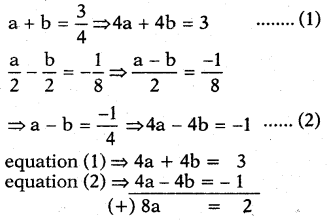
⇒ a = 2/8 = 1/4
Substituting a = 1/4 in equation (1) we get
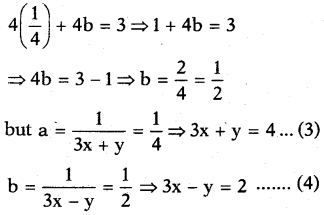
Solving (3) and (4)

⇒ x = 6/6 = 1
Substituting x = 1 in 3x + y = 4
⇒ 3(1) + y = 4
⇒ y = 4 - 3 = 1
∴ The solution (x, y) = (1, 1)
Question 2.
Formulate the following problems as a pair of equations and then find their solutions.
i) A boat goes 30 km upstream and 44 km downstream in 10 hours. In 13 hours it can go 40 km upstream and 55 km downstream. Determine the speed of the stream and that of the boat in still water.
Answer:
Let the speed of the boat in still water = x kmph
and the speed of the stream = y kmph
then speed in downstream = x + y
Speed in upstream = x - y
and time =distance/speed
By problem,
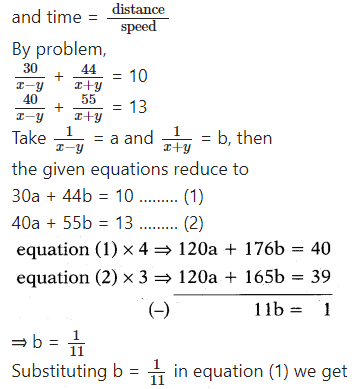
⇒ b = 1/11
Substituting b = 1/11 in equation (1) we get
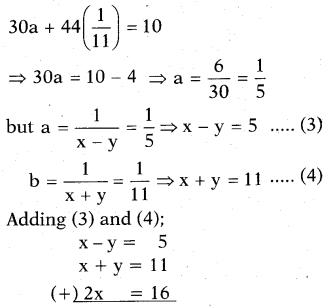
⇒ x = 8
Substituting x = 8 in x - y = 5 we get
8 - y = 5
⇒ y = 8 - 5 = 3
∴ The solution (x, y) = (8, 3)
Speed of the boat in still water = 8 kmph
Speed of the stream = 3 kmph.
ii) Rahim travels 600 km to his home partly by train and partly by car. He takes 8 hours if he travels 120 km by train and rest by car. He takes 20 minutes more if he travels 200 km by train and rest by car. Find the speed of the train and the car.
Answer:
Let the speed of the train be x kmph
and the speed of the car = y kmph
By problem,
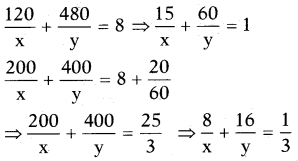
Take 1/x = a and 1/y = b, then
the given equations reduce to
15a + 60b = 1 ... (1)
8a + 16b = 1/3 ⇒ 24a + 48b = 1 ... (2)

⇒ a = -1/-60 = 160
Substituting a = 1/60 in equation (1) we get
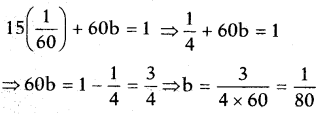
but a = 1/x = 1/60 ⇒ x = 60 kmph
b = 1/y = 1/80 ⇒ y = 80 kmph
Speed of the train = 60 kmph and
speed of the car = 80 kmph
iii) 2 women and 5 men can together finish an embroidery work in 4 days while 3 women and 6 men can finish it in 3 days. Find the time taken by 1 woman alone and 1 man alone to finish the work.
Answer:
Let the time taken by 1 woman to complete the work = x days
and time taken by 1 man to complete the work = y days
∴ Work done by 1 woman in 1 day =1/x
Work done by 1 man in 1 day =1/y
By problem,
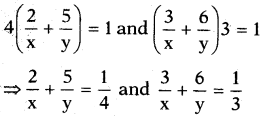
Take 1/x = a and 1/y = b,
then the above equations reduce to
2a + 5b = 1/4 and 3a + 6b = 1/3
⇒ 8a + 20b = 1 .... (1) and
9a + 18b = 1 ... (2)
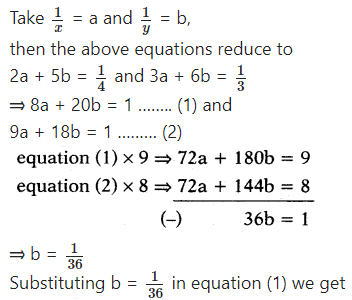
⇒ b = 1/36
Substituting b = 1/36 in equation (1) we get
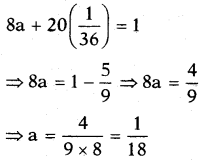
but a = 1/x = 1/18 ⇒ x = 18 and
b = 1/y = 1/36 ⇒ y = 36
∴ Time taken by 1 woman = 18 days
1 man = 36 days